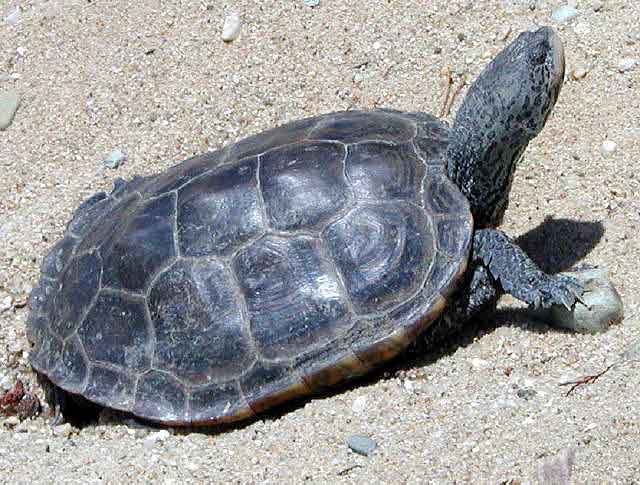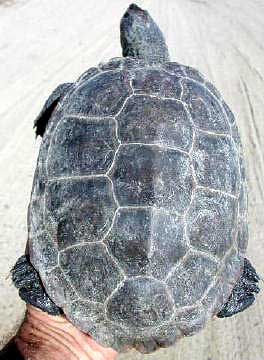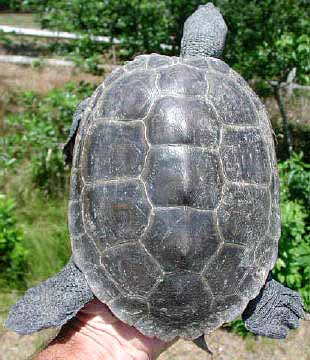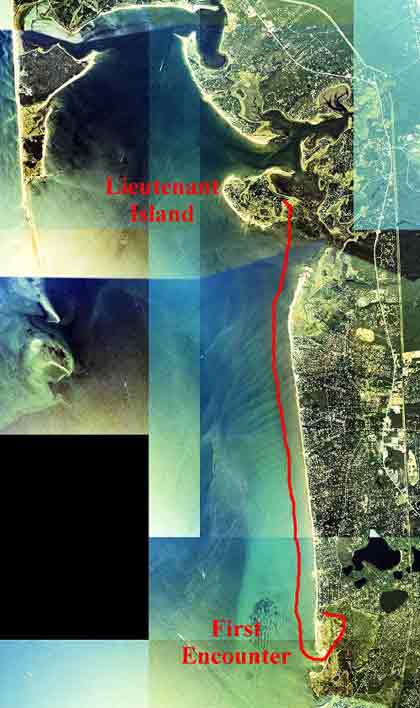Have You Heard the Story About the Traveling Terrapin?
— 13 July 2002
Once upon a time there was a female terrapin named #220. As one of the northernmost population of diamondback terrapins, she lived in the estuary system of Wellfleet Bay on the Outer Cape.

We first saw Terrapin 220 when she was a young lady around 10 years old in July 1990. She was spotted covering her nest on the east side of Lieutenant Island’s Turtle Point. At a weight of only 700 grams after laying her second clutch of the year and a carapace length of 16.8 centimeters, #220 was probably in her second season of nesting.
By 2001 she had grown to 19.9 centimeters, and when she came ashore (both on the south side of Lieutenant Island) for her first clutch on 14 June and her second clutch on 28 June, she weighed 1350 and 1300 grams, respectively. So, we weren’t too surprised this year when Chris Burns found her in the same area for her first nesting run of the season (see A Nesting Homerun -- 21 June 2002). And then 15 days later she returned to Lieutenant Island for her second clutch, but she was disturbed by holiday traffic and returned to the marsh.
So far, everything tracks perfectly with what we know about Terrapin 220 and what we think we know about terrapins. But life, especially turtle life, is never so simple.
The call came from Eastham late this morning at 11:30 a.m. A turtle had crossed the tourist-clogged asphalt road to First Encounter Beach and was trying to scratch a nest in a graveled driveway. Racing from Wellfleet far to the north —in fact, from the identical spot where #220 had last been spotted on 5 July 2002 — I jeeped south to Bayshore Lane in Eastham to see this turtle. How surprised do you think I was when she turned out to be the very same Terrapin #220? She had traveled nearly 6.5 miles from Lieutenant Island to First Encounter Beach in eight days while still quite gravid. Despite the physical evidence of her marks and her measurements and her weight, I still refused to believe it was she until I examined the digital mug shots (5 July on the left and 13 July on the right). She had the same split nuchal and split 9/90 (12 left and 12 right) marginals * and identical scrapes and scarring. It was, in short, the same turtle.
 
 
And she represents the first turtle from the Wellfleet Bay population that we have confirmed outside of that estuary system. As with all good turtle stories, some mysteries get explained while others just get more mysterious. For example, we have from time to time found terrapin hatchlings in the most inappropriate places along the long stretch of exposed beach from Wellfleet to Eastham. When we discover them, we shrug in disbelief because there are no nearby marsh estuaries from whence the turtles could have come. Well, clearly that was before we had learned about traveling terrapin #220.
As for why she would make such a long journey while still very gravid, we haven’t a clue. She was disturbed on her 5 July nesting attempt and went back into the marsh. But there were no storms between 5 July and today to toss her seaward. There were, however, some substantial new moon tides that could have flushed her far enough into Cape Cod Bay that she lost her bearings. How she navigated the long stretch of open water from Wellfleet to the next marsh estuary more than six miles south in Eastham remains a deep mystery. And how she found her way to a prime nesting spot for Eastham turtles behind First Encounter Beach is just as mysterious.
* See explanation of the marking system used for the terrapins in Welfleet Bay.

|